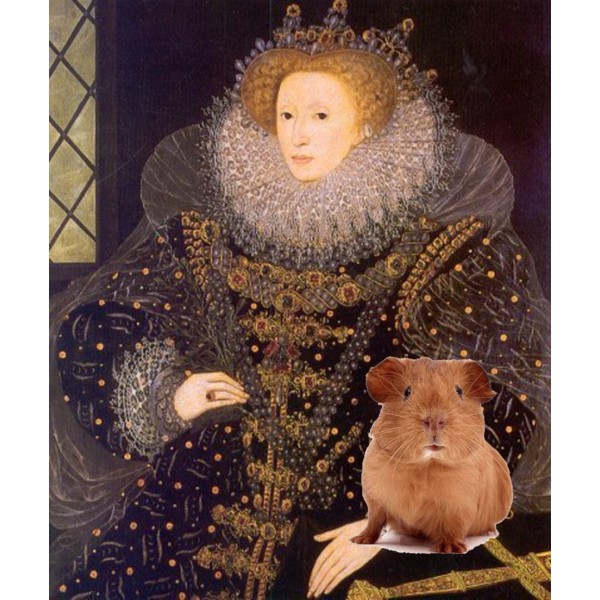I love guinea pigs. My children love guinea pigs. My husband is neutral on the subject, or so he says. We currently have three female guinea pigs. They are social creatures and get very depressed when alone. In Sweden it is against the law to sell one guinea pig per customer unless the customer already has at least one. Our piggy, Lily, lost her two companions to old age and was alone for a while. We went to our local S.P.C.A. recently to see if they had a female piggy up for adoption. Of course they had two sisters, and now we once again have three little piggies: Lily + Nelly & Iris.
Here are Pippin and Cookie, two who have passed on and were dearly loved:

Very few of the world’s domesticated animals come from the new world: guinea pigs (Peru; 5000 BCE), llamas (Peru; 3500 BCE), alpacas (Peru; 1500 BCE), turkeys (Mexico; 500 BCE) and the Muscovy duck (place and time unknown) make up the entire collection. In the Andes guinea pigs are mainly livestock – 65 million are consumed in Peru annually.
Traders brought guinea pigs to Europe where they were quickly added to aristocratic household menageries. Queen Elizabeth I is rumored to have had at least one.

Not only do I love guinea pigs, I love trickster tales as well. When you find a story that combines the two, you know you’ve got something special. Love and Roast Chicken: A Trickster Tale From the Andes Mountains written and illustrated by Barbara Knutson (1959 – 2005) is one such story.
The following bio is from barbaraknutson.com (linked above):
Barbara Knutson was born in South Africa as the child of American missionaries. Drawing, reading, and “making things” were her favorite pastimes, and animals, wild or tame, were her favorite subject. She was twelve when her family moved to the United States. After high school in Bloomington, MN, Barbara attended St. Olaf College and the University of Minnesota. With degrees in Art Education and French, she went to Nigeria to teach at an international school for two years. But reading, drawing, and “making things” prevailed, and on returning to the United States she wrote and illustrated her first book, Why the Crab Has No Head. A trip to Tanzania led to two more African animal tales: How the Guinea Fowl Got Her Spots: A Swahili Tale of Friendship and Sungura and Leopard: A Swahili Trickster Tale.
For two years Barbara lived in Lima, Peru, where her husband Chris Jensen taught biology. Hiking and traveling in Bolivia and Peru, she learned an Andean trickster tale that eventually turned into the picturebook Love and Roast Chicken.
Barbara passed away in May 2005. She will be greatly missed by many people around the world.
Love and Roast Chicken is the first book of Barbara Knutson’s that I’ve read. The Web site has more information about the making of the book, plus educational materials for teachers, some of which can be downloaded directly. The story features Cuy (pronounced KWEE; means guinea pig) the guinea pig and his foil, Tío (pronounced TEE-oh; means uncle) Antonio the fox. In the author’s notes we learn that Tío Antonio is a traditional Andean name for the fox.
While Cuy does what every guinea pig does best – eat – he becomes the target of a hungry fox. But Cuy outwits Tío Antonio by convincing him the sky is falling and, when the fox persists, that the end of the world is coming. Believing that his fox troubles are over, the emboldened guinea pig dresses like a little man and takes the job of a farm hand, giving him nightly access to the alfalfa that grows there. Of course, the farmer notices that someone is nipping off with his crop and fashions a small creature made of clay. Cuy becomes hopelessly stuck while trying to befriend the clay creature. Tío Antonio shows up and Cuy outwits him once and for all in the most astonishing manner (involving love and roast chicken, obviously).
The book jacket claims the book has “an authentic South American voice.” The illustrations are warm, yet vibrant, and full of the details of Andean life that Barbara Knutson recorded in her sketchbook while she lived there. I want to give away the conclusion – it is hysterically funny – but I’m forcing myself to hold back. I hope you’ll read it with a child or two (or more).

6 responses to “An unlikely trickster, his kin and a Queen”
Testing
I've requested Love and Roast Chicken from the library. Can't wait to read it.
Glad to know Liz had good help running the country.
You can count on guinea pigs to bring the best out of people.
Glad to know Liz had good help running the country.
You can count on guinea pigs to bring the best out of people.